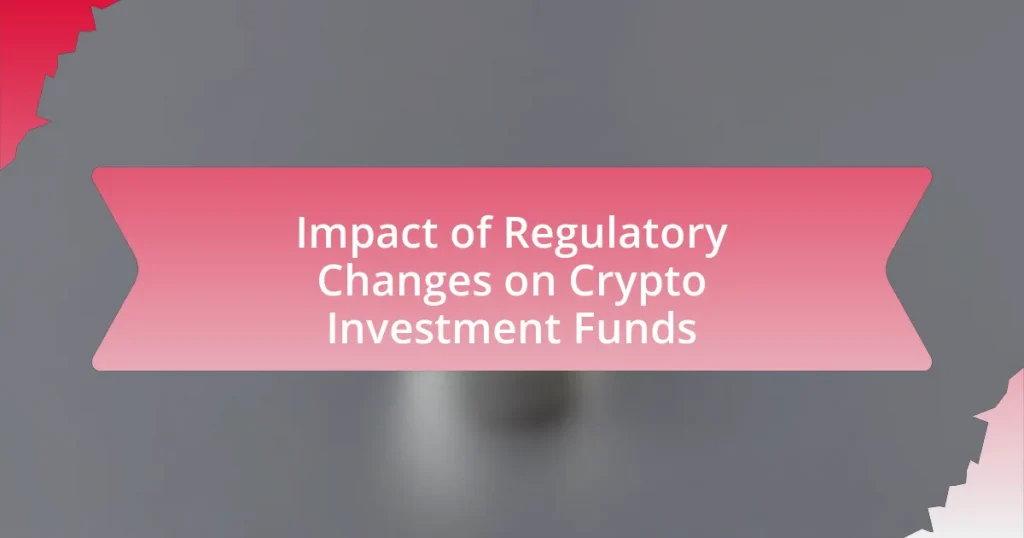The article focuses on the impact of regulatory changes on crypto investment funds, highlighting the increased scrutiny from financial authorities, new licensing requirements, and the implementation of anti-money laundering (AML) and know-your-customer (KYC) regulations. It discusses how these changes, particularly the European Union’s Markets in Crypto-Assets (MiCA) regulation and U.S. Securities and Exchange Commission (SEC) actions, are designed to enhance investor protection and market integrity. The article further explores the implications of these regulations on investment strategies, risk management practices, and the overall crypto investment landscape, emphasizing the importance of compliance for attracting institutional investors and fostering market confidence.

What are the Regulatory Changes Affecting Crypto Investment Funds?
Regulatory changes affecting crypto investment funds include increased scrutiny from financial authorities, the introduction of specific licensing requirements, and the implementation of anti-money laundering (AML) and know-your-customer (KYC) regulations. For instance, the U.S. Securities and Exchange Commission (SEC) has been actively enforcing regulations that classify certain cryptocurrencies as securities, which requires funds to register and comply with securities laws. Additionally, the European Union’s Markets in Crypto-Assets (MiCA) regulation aims to create a comprehensive regulatory framework for crypto assets, impacting how investment funds operate within the EU. These changes are designed to enhance investor protection and reduce risks associated with market manipulation and fraud.
How do these regulatory changes impact the overall crypto investment landscape?
Regulatory changes significantly impact the overall crypto investment landscape by establishing clearer guidelines and compliance requirements for investors and institutions. These changes can enhance investor confidence, as they reduce the risks associated with regulatory uncertainty, leading to increased institutional participation in the market. For instance, the introduction of the European Union’s Markets in Crypto-Assets Regulation (MiCA) aims to create a comprehensive regulatory framework that promotes transparency and security, which can attract more traditional investors. Additionally, regulatory clarity can facilitate the development of innovative financial products, such as crypto exchange-traded funds (ETFs), further broadening the investment options available to both retail and institutional investors.
What specific regulations have been introduced recently?
Recently, the European Union introduced the Markets in Crypto-Assets (MiCA) regulation, which aims to create a comprehensive regulatory framework for cryptocurrencies and related services. This regulation establishes clear guidelines for the issuance and trading of crypto assets, ensuring consumer protection and market integrity. Additionally, the United States has implemented the Financial Action Task Force (FATF) guidelines, which require cryptocurrency exchanges to comply with anti-money laundering (AML) and know-your-customer (KYC) regulations. These regulations are designed to enhance transparency and reduce the risk of illicit activities within the crypto market.
How do these regulations differ across various jurisdictions?
Regulations governing crypto investment funds vary significantly across jurisdictions, primarily due to differing legal frameworks, regulatory bodies, and approaches to risk management. For instance, the United States employs a fragmented regulatory approach, with the Securities and Exchange Commission (SEC) overseeing securities laws while the Commodity Futures Trading Commission (CFTC) regulates derivatives. In contrast, the European Union has proposed a more unified framework through the Markets in Crypto-Assets (MiCA) regulation, aiming to create a comprehensive regulatory environment for crypto assets across member states. Additionally, jurisdictions like Singapore and Switzerland have established clear guidelines that promote innovation while ensuring investor protection, contrasting with more restrictive environments in countries such as China, where crypto trading is largely banned. These differences reflect varying priorities in balancing innovation, consumer protection, and financial stability.
Why are regulatory changes important for crypto investment funds?
Regulatory changes are important for crypto investment funds because they establish a framework that enhances investor protection and market integrity. These regulations help to mitigate risks associated with fraud, market manipulation, and volatility, which are prevalent in the cryptocurrency market. For instance, the implementation of the Financial Action Task Force (FATF) guidelines has led to increased compliance measures among crypto funds, ensuring that they adhere to anti-money laundering (AML) and know-your-customer (KYC) protocols. This compliance not only builds trust among investors but also attracts institutional capital, as firms are more likely to invest in a regulated environment.
What risks do regulatory changes pose to investors?
Regulatory changes pose significant risks to investors by altering the legal landscape in which their investments operate. These changes can lead to increased compliance costs, potential penalties for non-compliance, and even the possibility of asset confiscation. For instance, the introduction of stricter regulations can limit the types of investments available, as seen in the European Union’s Markets in Crypto-Assets Regulation, which aims to create a comprehensive regulatory framework for cryptocurrencies. This can result in reduced market liquidity and increased volatility, negatively impacting investor returns. Additionally, regulatory uncertainty can lead to market panic, as evidenced by the sharp declines in cryptocurrency prices following announcements of potential regulatory actions in various jurisdictions.
How can regulatory compliance enhance investor confidence?
Regulatory compliance enhances investor confidence by ensuring that investment funds adhere to established legal and ethical standards. When funds comply with regulations, they demonstrate transparency, accountability, and a commitment to protecting investors’ interests. For instance, a study by the CFA Institute found that 75% of investors are more likely to invest in funds that are regulated, as compliance reduces perceived risks associated with fraud and mismanagement. This trust is crucial in the volatile crypto market, where regulatory frameworks can provide a safety net, thereby attracting more investors and fostering a stable investment environment.

What are the Effects of Regulatory Changes on Crypto Investment Strategies?
Regulatory changes significantly impact crypto investment strategies by altering the legal landscape in which investors operate. For instance, the introduction of stricter regulations can lead to increased compliance costs and operational challenges for crypto funds, prompting them to adjust their investment approaches to mitigate risks. A notable example is the implementation of the European Union’s Markets in Crypto-Assets (MiCA) regulation, which aims to provide a comprehensive framework for crypto assets, influencing how funds assess risk and allocate capital. Additionally, regulatory clarity can enhance investor confidence, potentially leading to increased institutional investment in cryptocurrencies, as seen after the U.S. Securities and Exchange Commission’s (SEC) clearer stance on Bitcoin ETFs. Thus, regulatory changes can either constrain or facilitate investment strategies, depending on the nature of the regulations enacted.
How do regulatory changes influence investment strategies in crypto funds?
Regulatory changes significantly influence investment strategies in crypto funds by altering the legal landscape in which these funds operate. When regulations become stricter, crypto funds may shift their strategies to ensure compliance, often leading to a reduction in the types of assets they can invest in or changes in their risk management approaches. For instance, the introduction of the Financial Action Task Force’s (FATF) Travel Rule in 2019 prompted many funds to enhance their anti-money laundering (AML) practices, which in turn affected their operational costs and investment decisions. Additionally, regulatory clarity can attract institutional investors, prompting funds to adjust their strategies to accommodate larger, more risk-averse capital sources. This dynamic illustrates how regulatory frameworks directly shape the operational and strategic decisions of crypto funds.
What adjustments do fund managers need to make in response to regulations?
Fund managers need to enhance compliance protocols and reporting mechanisms in response to regulations. This includes implementing robust risk management frameworks to identify and mitigate regulatory risks, ensuring adherence to anti-money laundering (AML) and know-your-customer (KYC) requirements, and adjusting investment strategies to align with new legal standards. For instance, the Financial Action Task Force (FATF) guidelines necessitate that fund managers conduct thorough due diligence on clients and transactions, which may require additional resources and technology investments to maintain compliance.
How do these changes affect risk management practices?
Regulatory changes significantly enhance risk management practices in crypto investment funds by imposing stricter compliance requirements. These regulations necessitate the implementation of robust internal controls, risk assessment frameworks, and reporting mechanisms to ensure transparency and accountability. For instance, the Financial Action Task Force (FATF) guidelines mandate that funds conduct thorough due diligence on clients and transactions, which directly mitigates risks associated with money laundering and fraud. Additionally, the introduction of capital adequacy requirements compels funds to maintain sufficient reserves, thereby reducing the likelihood of insolvency during market volatility. These measures collectively strengthen the overall risk management framework, ensuring that funds are better equipped to navigate the complexities of the crypto market.
What opportunities arise from regulatory changes for crypto investment funds?
Regulatory changes create opportunities for crypto investment funds by providing clearer guidelines and frameworks for compliance, which can enhance investor confidence. For instance, the introduction of regulations can lead to the establishment of licensed custodians, enabling funds to securely manage digital assets. Additionally, regulatory clarity can facilitate institutional investment, as firms are more likely to allocate capital to compliant funds. Historical examples include the approval of Bitcoin ETFs in various jurisdictions, which significantly increased market participation and liquidity. These developments illustrate how regulatory changes can transform the landscape for crypto investment funds, making them more attractive to a broader range of investors.
How can funds leverage new regulations to attract investors?
Funds can leverage new regulations to attract investors by ensuring compliance and enhancing transparency, which builds trust. For instance, regulations that mandate clearer reporting and disclosure can help funds demonstrate their legitimacy and operational integrity. According to a report by PwC, 78% of investors consider regulatory compliance as a critical factor in their investment decisions. By aligning with these regulations, funds can not only mitigate risks but also position themselves as safer investment options, thereby appealing to a broader range of investors.
What innovative investment products can emerge from regulatory frameworks?
Innovative investment products that can emerge from regulatory frameworks include tokenized assets, which allow for fractional ownership of real-world assets, and decentralized finance (DeFi) protocols that offer new lending and borrowing mechanisms. Regulatory clarity can enable the development of exchange-traded funds (ETFs) based on cryptocurrencies, providing traditional investors with easier access to digital assets. Additionally, compliance-focused stablecoins can emerge, offering a regulated alternative to existing cryptocurrencies while maintaining price stability. These products are supported by the increasing demand for secure and compliant investment options in the evolving crypto landscape.

What are the Future Implications of Regulatory Changes on Crypto Investment Funds?
Future regulatory changes will likely lead to increased compliance requirements for crypto investment funds, impacting their operational costs and investment strategies. As governments worldwide implement stricter regulations to enhance transparency and protect investors, funds may need to invest in compliance infrastructure, which could reduce profit margins. For instance, the European Union’s Markets in Crypto-Assets (MiCA) regulation aims to create a comprehensive regulatory framework, potentially influencing how funds operate within the EU. Additionally, regulatory clarity may attract institutional investors, increasing market legitimacy and potentially driving up asset values. However, the evolving regulatory landscape may also lead to market volatility as funds adapt to new rules, affecting investor confidence and fund performance.
How might future regulatory trends shape the crypto investment landscape?
Future regulatory trends will likely create a more structured and secure environment for crypto investments, enhancing investor confidence and participation. As governments worldwide develop clearer frameworks, such as the European Union’s Markets in Crypto-Assets Regulation (MiCA), these regulations will establish standards for transparency, consumer protection, and anti-money laundering measures. This shift is expected to attract institutional investors who have previously been hesitant due to regulatory uncertainties. For instance, a report by Fidelity Digital Assets in 2021 indicated that 70% of institutional investors were interested in crypto, but regulatory clarity was a significant factor in their decision-making process. Thus, as regulations evolve, they will shape the crypto investment landscape by fostering legitimacy and encouraging broader market participation.
What potential regulations are being discussed in the industry?
Potential regulations being discussed in the crypto investment fund industry include stricter compliance requirements for anti-money laundering (AML) and know your customer (KYC) protocols. Regulatory bodies, such as the U.S. Securities and Exchange Commission (SEC) and the European Securities and Markets Authority (ESMA), are considering frameworks that would mandate greater transparency and reporting obligations for crypto funds. For instance, the SEC has proposed rules that would classify certain cryptocurrencies as securities, thereby subjecting them to existing securities regulations. This shift aims to enhance investor protection and market integrity, reflecting ongoing concerns about fraud and market manipulation in the crypto space.
How can funds prepare for anticipated regulatory changes?
Funds can prepare for anticipated regulatory changes by conducting thorough compliance assessments and developing adaptive strategies. This involves regularly reviewing existing regulations and potential changes, engaging with legal experts to interpret new rules, and implementing robust compliance frameworks. For instance, the Financial Action Task Force (FATF) has issued guidelines that require funds to enhance their anti-money laundering (AML) and know-your-customer (KYC) practices, which necessitates proactive adjustments in operational protocols. By staying informed and agile, funds can mitigate risks associated with regulatory non-compliance and ensure they meet evolving legal standards.
What best practices should crypto investment funds adopt in light of regulatory changes?
Crypto investment funds should adopt a proactive compliance strategy to navigate regulatory changes effectively. This includes implementing robust Know Your Customer (KYC) and Anti-Money Laundering (AML) procedures to meet legal requirements and mitigate risks. Additionally, funds should regularly update their compliance frameworks to align with evolving regulations, as seen in jurisdictions like the European Union, which has introduced the Markets in Crypto-Assets (MiCA) regulation to enhance oversight. Engaging legal experts to interpret regulatory developments and conducting regular audits can further ensure adherence to laws, thereby protecting investors and maintaining market integrity.
How can funds ensure ongoing compliance with evolving regulations?
Funds can ensure ongoing compliance with evolving regulations by implementing a robust compliance framework that includes regular monitoring of regulatory changes, staff training, and the use of compliance technology. This framework should involve continuous assessment of applicable laws and regulations, such as the Financial Action Task Force (FATF) guidelines and local jurisdiction requirements, to adapt to new legal landscapes. For instance, a study by Deloitte highlights that 80% of financial institutions have increased their compliance budgets in response to regulatory changes, indicating the importance of proactive measures. Additionally, utilizing compliance management software can streamline the process of tracking regulatory updates and managing compliance documentation, thereby enhancing the fund’s ability to remain compliant in a dynamic regulatory environment.
What role does transparency play in maintaining investor trust?
Transparency is crucial in maintaining investor trust as it fosters confidence and reduces uncertainty in investment decisions. When investors have access to clear, accurate, and timely information about a fund’s operations, financial performance, and regulatory compliance, they are more likely to feel secure in their investments. For instance, a study by the CFA Institute found that 78% of investors consider transparency a key factor in their investment decisions, highlighting its importance in building trust. Furthermore, regulatory frameworks that mandate transparency, such as the SEC’s disclosure requirements for investment funds, reinforce this trust by ensuring that investors are informed about potential risks and returns, thereby promoting a more stable investment environment.















